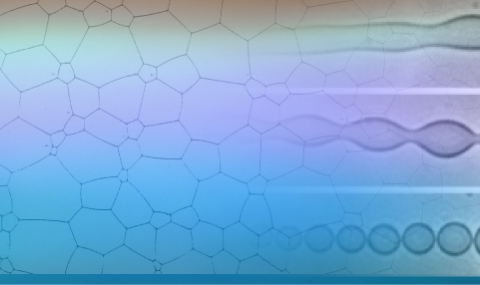Lambda phage is paradigm system to study how a biological decision is made, an issue relevant to development. Much about fundamental biomolecular processes was discovered through the study of the behavior of lambda. Lambda phage belongs to a class of viruses called temperate, meaning that after attacking a bacterial cell such as E. coli, the phage must decide between two fates: lysis or lysogeny. When the lytic pathway is chosen, the virus utilizes bacterial resources to replicate many times, until the cell bursts (lyses) with new viruses that can go and infect new cells. Alternatively, the viral genome can insert itself into the bacterial genome (the prophage state), stay dormant by repressing viral genes that lead to lysis and replicating passively with the bacterial genome. The lysogenic state is highly stable but DNA damage can result in an irreversible switch into the lytic pathway (induction).
We have followed the dynamics of both lytic and lysogenic pathways in real time upon infection of cell ensembles, and upon induction of lysogenic cells, both in ensembles and in individual cells, using promoter-GFP fusions. The accompanying movie shows cells expressing GFP from a fusion to the pR’-tR’ promoter, after induction of the lytic pathway by irradiation with UV light. Cells gradually become more fluorescent, and suddenly disappear from the field of view by undergoing lysis. We study temporal noise propagation, i.e. how timing fluctuations in the occurrence of early events give rise to larger timing fluctuations of later events along the induction genetic cascade, and how this reflects upon the cascade’s architecture.
"Noise in Timing of Gene Activity in a Genetic Cascade", A. Amir, O. Kobiler, A. Rokney, A. B. Oppenheim and J. Stavans, Mol. Sys. Biol. 3, 71 (2007).
"The Lysis-Lysogeny Decision in Bacteriophage Lambda", A. Oppenheim, O. Kobiler, J. Stavans, D. L. Court and S. Adhya, Annu. Revs. Gen. 39, 409 (2005).
"Quantitative Kinetic Analysis of the Bacteriophage Lambda Genetic Network: The Central Role of CII in the Lysis-Lysogeny Decision", O. Kobiler, A. Rokney, N. Friedman, J. Stavans, D. Court and A.B. Oppenheim, Proc. Nat. Acad. Sci. 102, 4470 (2005).


